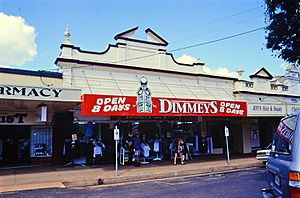- This page was last modified on 17 October 2025, at 10:18. Suggest an edit.
Ellwood & Co Drapery facts for kids
| Ellwood & Co Drapery | |
|---|---|

Former Ellwood & Co Drapery, 1996
|
|
| Location | 62 Churchill Street, Childers, Bundaberg Region, Queensland, Australia |
| Design period | 1900 - 1914 (early 20th century) |
| Built | c. 1907 |
| Architect | F H Faircloth |
| Architectural style(s) | Classicism |
| Official name: Ellwood & Co Drapery (former), F. Ellwood & Co Drapery, Boys Department Store, Dimmeys, Joys Hairdress | |
| Type | state heritage (built) |
| Designated | 21 October 1992 |
| Reference no. | 600617 |
| Significant period | 1900s (fabric) c. 1907-ongoing (historical use) |
| Lua error in Module:Location_map at line 420: attempt to index field 'wikibase' (a nil value). | |
The Ellwood & Co Drapery is a special old shop located at 62 Churchill Street in Childers, Australia. It was designed by F H Faircloth and built around 1907. This building is also known by other names like F. Ellwood & Co Drapery, Boys Department Store, Dimmeys, and Joys Hairdress. It's important because it's listed on the Queensland Heritage Register, which means it's protected for its historical value.
Contents
A Town Rebuilt: The Story of Childers
The Big Fire of 1902
Imagine a whole street of shops burning down! That's what happened in Childers on 23 March 1902. A huge fire swept through the main street, Churchill Street. Most buildings were made of timber and built very close together. Childers didn't even have a fire brigade back then. This fire destroyed almost all the shops on the south side of the street.
Childers Grows Up
Before the fire, Childers was a small town. It grew because of logging in the nearby Isis Scrub in the 1870s. Then, a railway line opened in 1887. This helped transport timber and later, sugar. The sugar industry really took off in the 1890s. Childers became a busy center for sugar farming.
Rebuilding the Town
After the devastating fire, the town needed to be rebuilt. Many new buildings were made of stronger materials like brick. This changed Childers from a frontier town with wooden buildings to a more established center. An architect named Frederic Herbert Faircloth, often called Herb, was very important in this rebuilding. He was from Bundaberg and designed many of the new buildings in Childers. His designs gave the town its new, solid look.
The Ellwood & Co Drapery Building
The Ellwood & Co Drapery building was built around 1907. It was one of the new buildings put up after the fire. It was designed as a single, large shop. It had big glass windows and decorative columns. These features were common in the new buildings designed by Faircloth.
The shop was first leased to William Hood and Frederick William Ellwood. They ran it as F Ellwood & Co, selling clothes and fabrics. For many years, it continued to be a drapery or clothing store. Later, it became part of Boys Pty Ltd, another clothing store. Today, part of the building is a hairdressing salon, and the main part is still a clothing store called Dimmeys.
What Does It Look Like?
The former Ellwood's Drapery is a single-story building made of brick. It's on the south side of Churchill Street, the main street in Childers. Like many other shops on this street, it has a roof hidden by a decorative wall called a parapet. This parapet has a classic design, with a broken pediment and two urns on top.
The awning that stretches over the footpath is now supported differently than it used to be. The shop has modern fronts and a new inside. However, the part of the building used as a hairdresser has been rebuilt to look more like the original shop front.
Why Is It Important?
The former Ellwood & Co Drapery is listed on the Queensland Heritage Register because it's historically significant.
- A Glimpse into the Past: This building shows how Childers grew and changed in the early 1900s. It's a clear example of how towns rebuilt after big fires, especially when they didn't have good fire services.
- A Classic Design: It's a great example of what country town shops looked like in the early 1900s. You can see its classic awnings, shop fronts, and overall shape.
- Part of a Beautiful Street: The building helps make Churchill Street look so charming and unified. All the buildings together create a very picturesque townscape.
- Connected to a Famous Architect: It has a special link to the architect F.H. Faircloth. He designed many buildings in Childers, and this one shows his important work in shaping the town's appearance.
